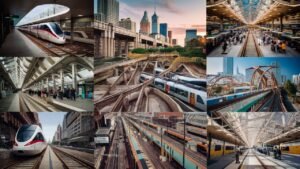The Steve Kamer Path Train stands as an emblem of modern transit solutions, seamlessly connecting urban dwellers to key destinations across bustling metropolitan landscapes. Known for its efficiency, reliability, and innovative design, the Path Train has become a vital lifeline for commuters. This article delves into the multifaceted aspects of the Steve Kamer Path Train, shedding light on its history, unique features, operational excellence, and its transformative impact on urban transit.
The Legacy of the Steve Kamer Path Train: A Historical Overview
The Steve Kamer Path Train is not just a mode of transport; it is a testament to visionary planning and urban development. Established to cater to the growing demand for efficient transit systems, it has evolved from its humble beginnings into a state-of-the-art network. This transformation reflects decades of strategic investments, innovative engineering, and a commitment to addressing the needs of an ever-growing population. By examining the milestones in its journey, we gain an appreciation for the foresight that has driven its success.
Innovative Design and Technology: The Backbone of the Path Train
One of the most distinguishing aspects of the Steve Kamer Path Train is its groundbreaking design and integration of cutting-edge technology. From its sleek train cars to its advanced signaling systems, every element has been meticulously crafted to enhance passenger experience and operational efficiency. The use of eco-friendly materials, energy-efficient propulsion systems, and digital ticketing platforms underscores the Path Train’s commitment to sustainability and user convenience. Furthermore, its implementation of real-time tracking and automated scheduling exemplifies how technology is harnessed to redefine urban commuting.
Operational Efficiency: How the Steve Kamer Path Train Sets the Standard
The Steve Kamer Path Train’s operational efficiency is a benchmark for transit systems worldwide. With minimal delays, precise scheduling, and an emphasis on safety, it has earned the trust of millions. The integration of AI-powered analytics ensures that passenger flow is managed seamlessly, even during peak hours. Maintenance protocols are another critical component, with advanced diagnostics reducing downtime and ensuring that trains remain in top condition. This dedication to operational excellence not only enhances reliability but also sets a standard for other transit systems to emulate.

Impact on Urban Mobility: Connecting Communities and Driving Growth
The Steve Kamer Path Train’s impact on urban mobility is profound, bridging the gap between residential areas and commercial hubs with unparalleled efficiency. By offering a viable alternative to road-based transportation, it significantly reduces traffic congestion and lowers carbon emissions. Furthermore, the accessibility of the Path Train has been instrumental in fostering economic growth, enabling businesses to thrive by facilitating easy commutes for employees and customers alike. Its role in connecting communities cannot be overstated, as it brings together diverse populations and enhances the overall quality of urban life.
Future Prospects: What Lies Ahead for the Steve Kamer Path Train?
As cities continue to expand, the Steve Kamer Path Train is poised to play an even more critical role in shaping the future of urban transit. Plans for expansion, including new routes and enhanced infrastructure, are already underway. Emerging technologies such as autonomous trains, predictive maintenance powered by AI, and improved energy storage solutions promise to further elevate its capabilities. Moreover, the focus on passenger-centric innovations, such as personalized travel experiences and enhanced accessibility features, ensures that the Path Train will remain at the forefront of transit solutions.
Conclusion: The Steve Kamer Path Train as a Model for Transit Excellence
In conclusion, the Steve Kamer Path Train is more than just a transit system; it is a symbol of progress, innovation, and community building. Its ability to adapt to the changing needs of urban populations while maintaining exceptional standards of efficiency and sustainability is a testament to its enduring relevance. As we look to the future, the Path Train serves as a blueprint for how modern transit systems can evolve to meet the demands of tomorrow while continuing to enrich the lives of those they serve today.